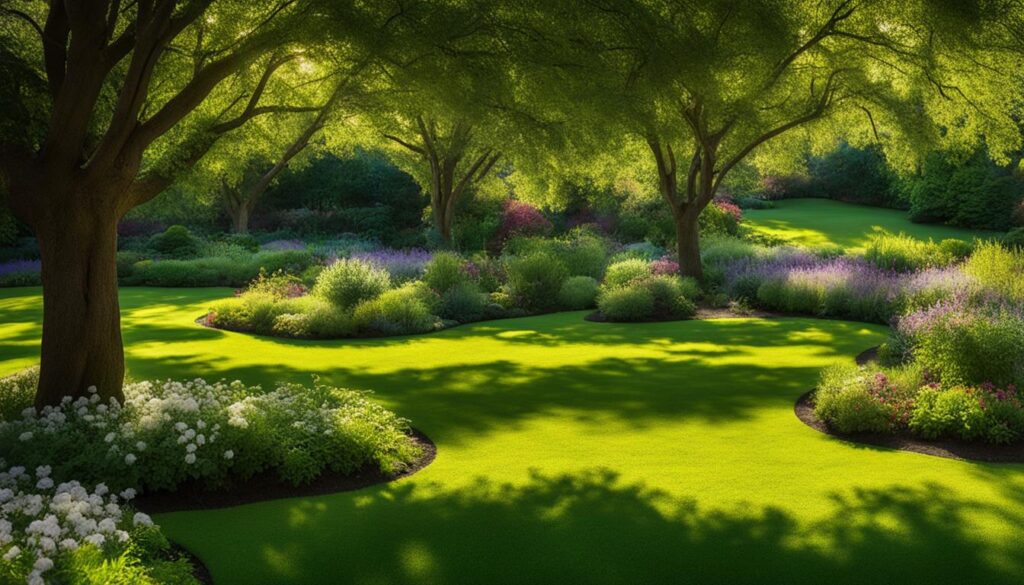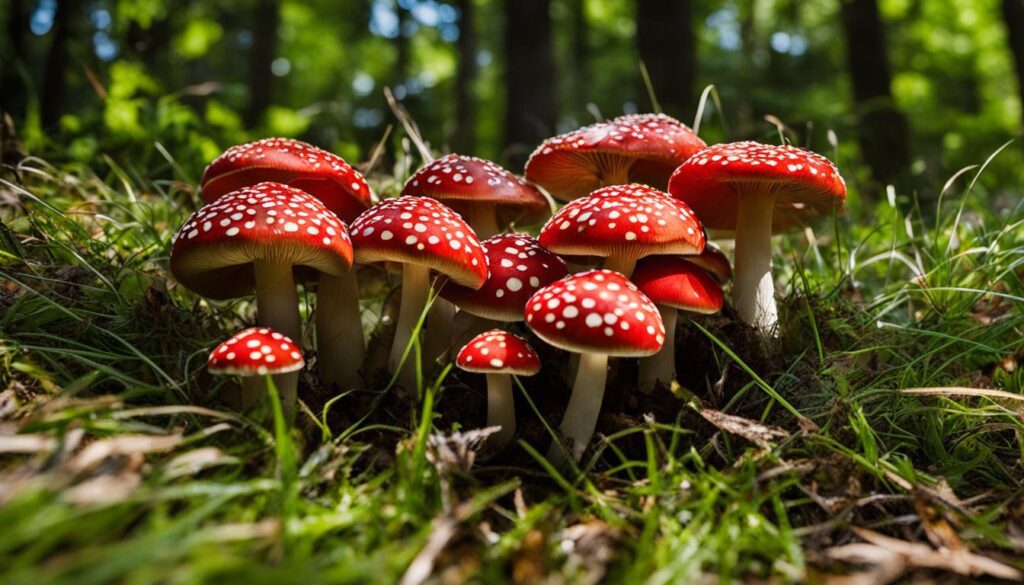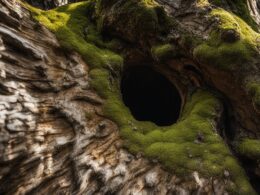Holes in the yard can be a frustrating problem for homeowners. They not only ruin the appearance of the lawn but can also pose safety hazards. To effectively manage and prevent these unsightly lawn blemishes, it is important to identify the cause of the holes. By understanding the potential culprits and implementing targeted strategies, you can find a solution to the mystery of holes in your yard.
Key Takeaways:
- Identifying the cause of holes in your yard is crucial for effective management and prevention.
- Holes in the yard can be caused by various factors, including slugs, shaded spots, gumbo soil, mushrooms, and drainage issues.
- Targeted strategies such as creating a shade garden, amending the soil, or creating a rain garden can help manage and prevent holes in your yard.
- Maintaining a healthy lawn requires regular maintenance and understanding the unique needs of your yard.
- Consulting with a professional landscaper or horticulturist can provide valuable insights and guidance for addressing holes in your yard.
Why Are There Holes in My Yard?
One possible cause of holes in your yard could be slugs. Slugs prefer to burrow into the soil, creating holes in search of a cool and moist environment. They tend to be active below ground, with only a small percentage above ground at any given time. During cold weather, slugs and snails hibernate in the topsoil, while in areas with mild winters, they can remain active throughout the year.
If you’ve noticed small holes in your yard, slugs may be the culprits. These slimy creatures are known for their ability to burrow into the soil, creating openings in search of a cool and moist environment. While slugs are primarily active below ground, a few may venture above the surface. In regions with mild winters, slugs can remain active and continue causing damage throughout the year.
Slugs are most commonly found in cool and moist environments, such as gardens and yards with plenty of vegetation. They are attracted to areas with ample organic matter and decaying vegetation, as these provide a favorable habitat for them. If your yard offers these ideal conditions, it’s not uncommon to find holes created by slugs.
While slugs can be a nuisance, they serve an ecological purpose. They break down decaying matter, contributing to nutrient cycling in the soil. However, if their population becomes too abundant, they can cause significant damage to your yard or garden.
To address the issue of slugs causing holes in your yard, there are several preventive measures you can take. Maintaining good drainage in your yard can help reduce slug populations, as they thrive in cool and moist environments. Regularly removing organic debris, such as fallen leaves and grass clippings, can also make your yard less attractive to slugs. Additionally, you may consider using slug barriers, such as copper strips or diatomaceous earth, to create a physical deterrent.
If you have a severe slug infestation, you can also opt for organic slug control methods, such as iron phosphate-based baits or nematodes. These can help reduce slug populations without causing harm to other beneficial organisms or the environment.
In conclusion, if you discover holes in your yard, slugs may be the cause. Their tendency to burrow into the soil in search of a cool and moist environment can result in unsightly and potentially damaging holes. By implementing preventive measures and taking appropriate slug control measures, you can effectively manage and minimize the impact of slugs in your yard.
Addressing Shaded Spots
If you have holes in your yard in shaded spots, the cause may be related to the lack of grass growth in those areas. Heavy shade from trees like oak trees can inhibit grass growth, resulting in small tufts of grass surrounded by bare earth.
In such cases, it may be beneficial to consider alternative landscaping options, such as creating a shade garden or planting drought-tolerant plants. When planting in shaded areas, it is important to choose shallow-rooted perennials and avoid planting too close to the tree trunk to prevent damage to the tree’s roots.
To address shaded spots in your yard, you can create pockets of soil where grass can thrive. This can be done by clearing the area of debris and competition, then adding fresh soil or compost. Planting grass seeds or placing sod in these prepared pockets will help establish new grass growth in the shaded spots. Additionally, you can place a bench or planters in shaded areas, adding beauty and functionality to these spots while minimizing the need for grass growth.
Remember that when dealing with shaded spots, the key is to choose grass varieties or plants that are specifically suited for low-light conditions. Drought-tolerant plants that can withstand dry soil and root competition from trees are ideal for these areas.
Dealing with Gumbo Soil
If your yard has holes and the soil is clay-like consistency, it may be due to the presence of gumbo soil. Gumbo soil is known for being mushy when wet and hard as concrete when dry, making it difficult for plants to grow. The lack of oxygen in clay soil can further complicate the situation, hindering root development and nutrient absorption.
One effective solution to improve gumbo soil is to amend it with expanded shale. This material helps to aerate the heavy clay soil, allowing it to drain more efficiently. By incorporating expanded shale into the soil, you can provide better airflow and create channels for excess water to escape.
In addition to expanded shale, the use of organic compost and mulch can further enhance the quality of gumbo soil. Organic compost adds valuable nutrients to the soil and improves its fertility, while mulch helps retain moisture and prevents excessive drying.
While expanded shale may be more expensive than other soil amendments, it offers a long-term and cost-effective solution to the challenges posed by gumbo soil. By improving drainage, enhancing soil fertility, and retaining moisture, this combination of amendments can create a favorable environment for plants to thrive. With the right approach, you can transform your gumbo soil into a healthy and productive garden bed.
Mushrooms in My Yard
If you notice mushrooms in your yard, they may be responsible for the holes in your lawn. While mushrooms can be unsightly, they actually play a beneficial role in the soil. They are part of the breakdown of organic material and help recycle nutrients.
Getting rid of mushrooms can be challenging as they are the fruiting bodies of an extensive underground root system. Pulling visible mushrooms or using fungicides may provide temporary relief, but the source of mushrooms will still remain.
The best approach is to make peace with the presence of mushrooms and educate yourself and your family about which ones are safe to eat.
Seasonal Swamp
If you have a low spot in your yard that fills with runoff during rainstorms, it can make it difficult to grow grass. One solution to address this issue is to create a rain garden.
A rain garden is a shallow depression in the ground that is amended with soil that drains quickly.
By planting water-loving plants in the rain garden, excess water can be captured and slowly percolate into the ground. Rain gardens not only help solve drainage problems but also create a wildlife-friendly habitat.
Can Using a Wood Chipper Help Fill in Holes in Yard?
Yes, renting a wood chipper can help fill in holes in your yard. By chipping wood and other organic materials, you can create a natural mulch that can be used to fill in holes and level out the surface of your yard. Rent a wood chipper to make the job easier and efficient.
Conclusion
Holes in the yard can be caused by various factors, including slugs, shaded spots, gumbo soil, mushrooms, and drainage issues. It is crucial to identify the specific cause of the holes in your yard to implement targeted strategies for managing and preventing them.
To address shaded spots, consider creating a shade garden or planting drought-tolerant plants that can thrive in those areas. For yards with gumbo soil, amending it with expanded shale and adding organic compost and mulch can improve drainage and soil fertility. If mushrooms are the culprit, remember that they play a beneficial role in soil health and it may be more advantageous to coexist with them, focusing on educating yourself and your family about safe-to-eat varieties.
In cases where there are low spots that collect runoff, creating a rain garden can help solve drainage problems while also providing a habitat for water-loving plants. Regular maintenance and understanding the unique needs of your yard are essential for maintaining a healthy lawn. By identifying the cause and implementing effective solutions, you can ensure a beautiful and well-maintained yard for years to come.











